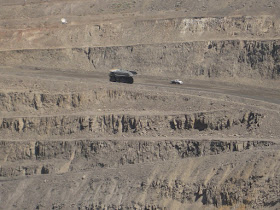
Kangaroo Island is a 45 minute ferry ride from the tip of the Fleriueux Penisunsula at Cape Jervis( which is 110 klms south of Adelaide), to Pennishaw on the northern end of the island. We had placed our caravan in storage and repacked our camping gear in the Pathfinder ready for our week on the island. Mike drove the car onto the ferry and I was fascinated watching the semi trailers full of sheep driving off the ferry and empty ones replacing them for the return journey.
KI as it is known to the locals, is an island of contrasts and stunning scenery.
The island is 45klms at its widest point and 150 klms long which makes it easy to explore. There is one sealed road which circles and crosses the island, all others are dirt but we found them well maintained.
There is a bit of everything here. You can go from
 calm bays to surf beaches within a very short distance and all with crystal clear water. From the majestic cliffs along the south coast and the many stunning white sandy beaches all around the island to the rolling hills of grain or grazing sheep and cattle, make it extremely picturesque.
calm bays to surf beaches within a very short distance and all with crystal clear water. From the majestic cliffs along the south coast and the many stunning white sandy beaches all around the island to the rolling hills of grain or grazing sheep and cattle, make it extremely picturesque.While driving around the island we have seen a large amount of wild life - echidna’s, koalas, heath goannas, Kangaroo Island kangaroos, possums, Tammar wallabies, Australian Sea-lions and New Zealand fur seals and many beautiful birds. Unfortunately there was also a lot of road kill.

There were so many bays and inlets that we fell in love with. The first was Stokes Bay where you have to squeeze your way along a pathway through huge rocks that open up to a stunning hidden sheltered beach. We were often the only ones on the beaches which always makes it feel special. Hanson Bay was another favourite, where we rented a cabin overlooking this idilic beach. We stayed here for two nights as it was raining and cold. The cabin had a fireplace so we sat by the fire and watched the waves. Unreal. Mike went fishing off the cliffs, caught two cod which he threw back. From the top of
 the cliffs you can see to the ocean floor the water is so clear. Magic!
the cliffs you can see to the ocean floor the water is so clear. Magic!Vivonne Bay is noted as one of Australia’s most beautiful beaches and we would have to agree. It is a large bay with fine white sand, transparent water, and a jetty. We spent time watching one of the lobster trawlers unloading their catches, and then the captain gave us some freshly caught snapper which fed us for two meals. Nice guy. Most of these fishermen spend at least five days at a time out at sea. We bought one of these lobsters as a treat and savoured every delicious mouthful.
There are two areas here to watch seals. Seal Bay has the Australian Sea Lions where you can get quite close and watch them lying and “hanging out” on the beach. The second area is Admirals Arch where the New Zealand fur seals spend their time on the rocky coastline. We watched them getting on and off the rocks in pounding surf and playing in the water where they are so agile. While on land they seem to spend most of their time sleeping, unless of course you are a young male who has to fight and annoy the others all the time

The island runs on a very slow pace which is perfect for a holiday. There are bountiful amounts of local produce including honey, cheeses, jams, oils, wine, delicious meats, sea food, eucalyptus products and I’m sure much more that we didn’t see. We visited a sheep dairy farm where we watched the sheep being milked and then sampled the cheeses and yoghurts
 made from it. The haloumi was delicious.
made from it. The haloumi was delicious.Our time on the island was so enjoyable we would recommend it to anybody.












































